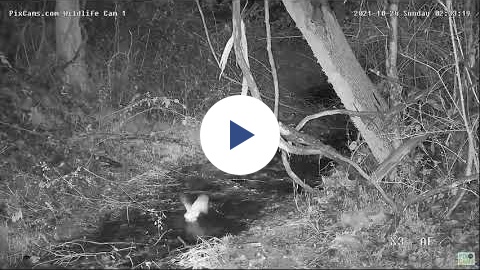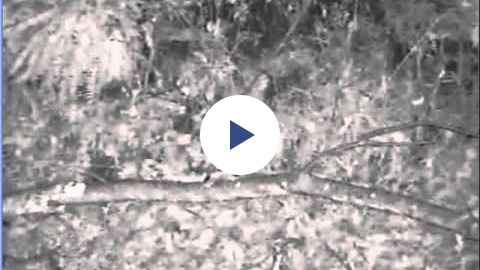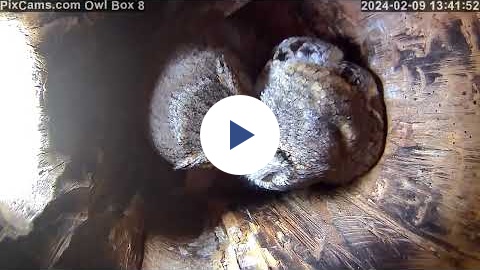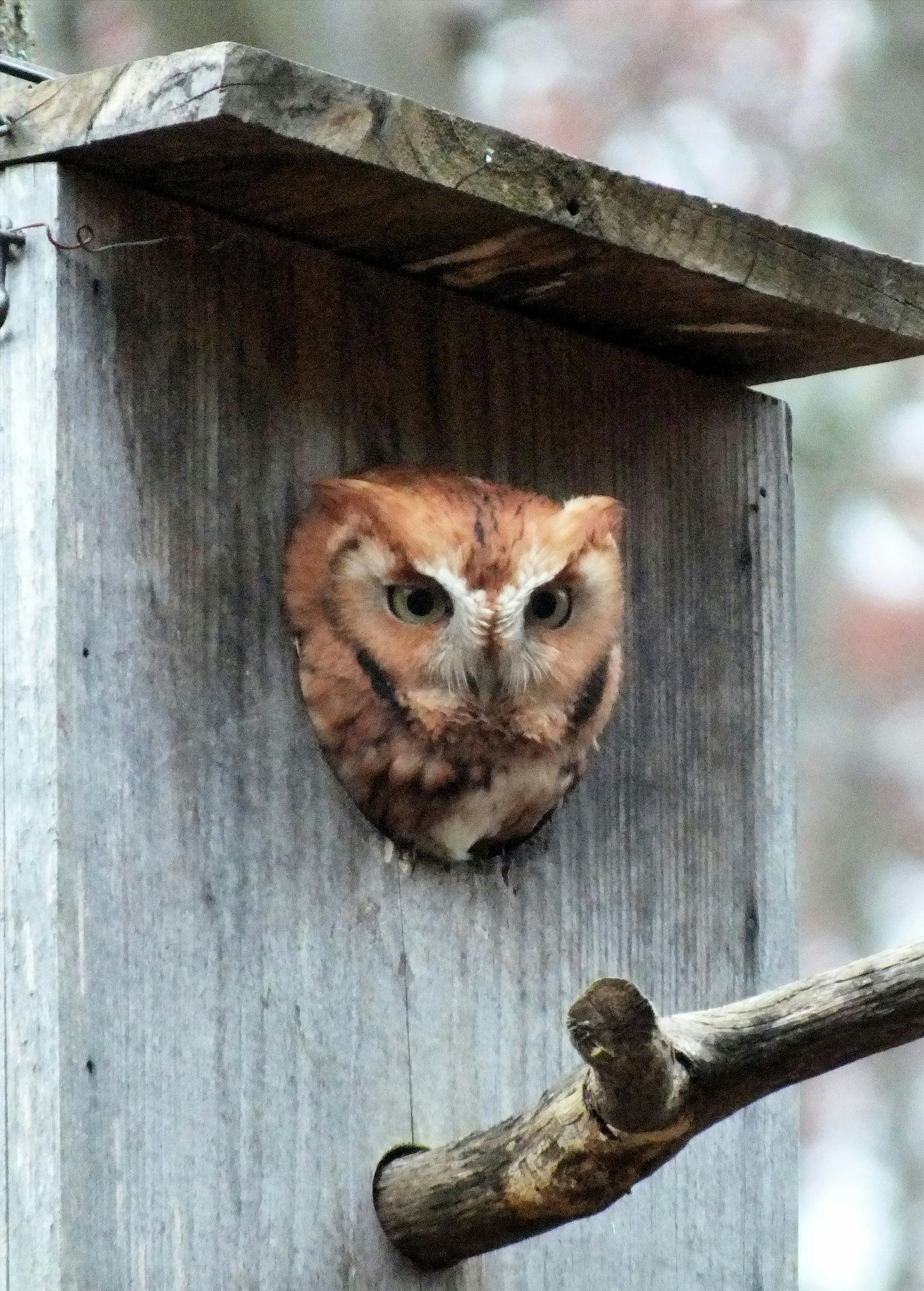About the Eastern Screech Owl
The Eastern Screech Owl is a small and adaptable owl species native to North America. With a height of about 7 to 10 inches and a wingspan of 18 to 24 inches, these owls exhibit remarkable camouflage, varying in color from reddish-brown to gray, enabling them to blend seamlessly with their surroundings. They possess distinctive tufts or “ear” feathers on their heads, which are often raised when the owl is alert. Eastern Screech Owls inhabit a diverse range of environments, including forests, parks, and suburban areas. They are primarily nocturnal hunters, preying on a variety of small creatures such as insects, rodents, and small birds. Known for their haunting and tremulous calls resembling a horse’s whinny, these owls use vocalizations for communication and during courtship. Eastern Screech Owls are cavity nesters, often utilizing abandoned woodpecker holes or nesting boxes. Their adaptability to diverse habitats has allowed them to coexist with human activities, making them a fascinating and sometimes overlooked resident of North American landscapes.
|
Eastern Screech Owl Roosting in a PixCams Owl Box |
Attracting Eastern Screech Owls to one’s backyard can be a rewarding endeavor for several reasons. These small and elusive owls contribute to the ecological balance by serving as natural pest controllers, preying on insects and rodents that may otherwise become nuisances. Observing Eastern Screech Owls in their natural habitat provides a unique and enchanting wildlife experience, allowing individuals to connect with the wonders of nature right in their own backyard. These owls are fascinating creatures with their distinctive calls and remarkable adaptations, adding an element of mystery and allure to the outdoor environment. Here are some tips we have been successful with in attracting the eastern screech owl.
Tip 1: Provide Nesting Boxes
Building a nest box for Eastern Screech Owls is a great way to provide them with a suitable nesting site. Here’s some advice to help you create an effective nest box:
|
Eastern Screech Owl Box Constructed by PixCams, Inc. |
Materials:
- Wood: Use untreated, rough-sawn lumber such as cedar or pine. Rough surfaces inside the box will help owlets climb and fledge.
- Size and Design: Construct the box with dimensions around 8-10 inches square for the floor, and a height of about 18 inches. Include a hinged roof for easy cleaning and monitoring.
- Entrance Hole: Make the entrance hole about 3 inches in diameter, which is suitable for Eastern Screech Owls. Install a predator guard around the entrance to prevent larger birds or mammals from reaching inside.
Construction Steps:
- Floor and Sides: Assemble the box with a bottom floor and four sides. Ensure that there are drainage holes in the bottom to prevent water buildup.
- Roof: Attach a sloping roof to protect the box from the elements. Make it hinged for easy access during cleaning and monitoring.
- Mounting: Mount the box on a tree or post at a height of 10 to 20 feet above the ground. Ensure the box is securely attached to prevent swinging in the wind.
- Ventilation: Drill small holes near the top of the sides to provide ventilation while preventing rain from entering.
Placement:
- Orientation: Face the entrance hole away from prevailing winds, typically towards the east or southeast, to protect the owlets from harsh weather.
- Avoidance of Disturbance: Place the box in a quiet area away from human traffic, but where you can observe it easily.
Maintenance:
- Cleaning: Clean the box annually during the late winter or early spring to remove any debris or old nesting material.
- Monitoring: While respecting the owls’ space, periodically check the box for activity or signs of occupation without causing unnecessary disturbance.
|
Eastern Screech Owl Nest Box Plans |
Tip 2: Create a Suitable Habitat
Eastern Screech Owls prefer areas with a mix of open spaces and wooded areas. If possible, maintain a natural habitat with trees and vegetation.
Avoid excessive use of pesticides to encourage a healthy population of insects and small mammals, which are their primary prey.
|
PixCams Eastern Screech Owl Box Setting |
Tip 3: Minimize Outdoor Lighting
Minimize outdoor lighting in your backyard as much as possible, as bright lights can disturb owls. If needed, use motion sensor lights to reduce constant illumination.
Tip 4: Provide a Water Source
Install a birdbath or small pond to provide a water source. Owls, like many birds, are attracted to areas with water.

Eastern Screech Owls, like many owl species, are not particularly drawn to water for drinking or bathing purposes. However, their affinity for areas near water is often linked to the increased abundance of prey and suitable habitats. Here are a few reasons why Eastern Screech Owls may be found in areas with water:
- Increased Prey Availability: Water sources such as ponds, streams, and wetlands attract a variety of small mammals, insects, amphibians, and other creatures. These serve as potential food sources for Eastern Screech Owls, making these areas ideal hunting grounds.
- Biodiversity: Habitats near water often have higher biodiversity, providing the owls with a diverse range of prey options. This diversity can be advantageous for sustaining owl populations.
- Ideal Roosting Sites: Trees surrounding water bodies may offer suitable roosting sites for Eastern Screech Owls. They often nest in tree cavities, and the proximity to water might provide additional shelter and safety.
While Eastern Screech Owls might be found near water, it’s essential to note that their primary attraction is the availability of prey and suitable habitats rather than a specific interest in water itself. Understanding the ecological factors that influence owl behavior can contribute to effective owl conservation and observation.
Tip 5: Provide Natural Prey Habitat
Encourage a diverse ecosystem with a variety of plants and trees to attract insects and small mammals, which are the primary food sources for Eastern Screech Owls.

Eastern Screech Owls are opportunistic hunters and have a diverse diet that typically includes a variety of small prey. Some of the main items in their diet include:
- Insects: Eastern Screech Owls feed on a variety of insects, such as beetles, moths, crickets, grasshoppers, and other small invertebrates.
- Small Mammals: Rodents like mice, voles, shrews, and occasionally small mammals such as bats form a significant portion of their diet.
- Birds: Eastern Screech Owls may prey on small birds, including sparrows, finches, and other songbirds. They are particularly adept at capturing birds in flight.
- Amphibians and Reptiles: These owls may consume amphibians like frogs and salamanders, as well as small reptiles such as lizards.
- Worms and Snails: Eastern Screech Owls may also eat earthworms and snails, especially when other food sources are less abundant.
Their diet can vary depending on factors like geographic location, seasonal availability of prey, and the specific environment they inhabit. These owls are skilled hunters, using their sharp talons and beaks to capture and consume a wide range of prey items. They are primarily nocturnal hunters, taking advantage of their excellent low-light vision and keen hearing to locate and capture prey in the dark.
Be Patient and Observant
Owls can be elusive, so be patient and observant. Setting up screech owl boxes and anticipating their occupancy requires a considerable dose of patience. Unlike other bird species that readily adapt to artificial nesting sites, screech owls can be particularly selective and cautious in choosing their habitat. These nocturnal raptors often take their time to investigate and become accustomed to new surroundings before considering them suitable for nesting. Rushing the process may result in the owls rejecting the box or, in extreme cases, abandoning it altogether. Patience is key to allowing these solitary and territorial birds to establish trust with the new environment. It takes time for them to assess the safety and suitability of the box, and they may need multiple seasons to feel entirely comfortable. By practicing patience during the setup phase, enthusiasts increase the likelihood of attracting these fascinating birds to their specially designed boxes and creating a harmonious, lasting partnership between human stewards and these elusive avian inhabitants.
Watch Screech Owls Live on PixCams
PixCams started installing screech owl boxes over a 30 acre area remote areas located in south western Pennsylvania in 2011. The camera system designed to monitor the screech owls is located in a wooded remote area unlike other screech owl webcams located in urban areas or backyards that are broadcast on the Internet.
Today there a a total of nine screech owl boxes fitted with small cameras and one external pan-tilt-zoom camera used to watch the screech owls hunt and move in/out of the owl boxes. Multiple owl boxes are needed for roosting, nesting, and caching of prey.
|
PixCams Screech Owl Boxes Broadcast Live |
Since 2011 we have had 4 different screech owl pairs use the boxes for nesting for a total of 7 nesting years. Our first nesting pair used our nest boxes for a nest in 2013 but it wasn’t until 2017 until we had our first successful nest. Over this period our nest boxes have successfully fledged 16 eastern screech owlets.
This year we have a new pair of eastern screech owls that have pair bonded and will hopefully use one of our nest boxes for nesting. If so, this will mark our 5th pair of owls nesting in our boxes.

The above video is the pair of screech owls that have pair bonded and we expect them to nest in one of our screech owl boxes this year. The names for this new pair are Lala and Grayson. The pair of owls were named by the brother & sister team of Jack and Mila Cortinovis-Jablonski. Thank you Jack and Mila for your naming efforts!
Be sure to visit https://pixcams.com/screech-owls/ to watch our screech owls this spring!


